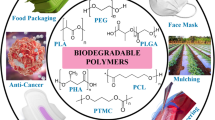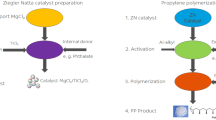Abstract
In the framework of synthesis of potentially functional macromolecules based on commodity polymers with naturally occurring compounds, the nitroxide-mediated polymerization of styrene with limonene was investigated here. Various ratios of styrene and limonene were used, and the incorporation of limonene in the final polymer was monitored. Results from benzoyl peroxide/TEMPO-initiated polymerization showed small incorporation of limonene in the polystyrene chains, while it was also involved in forming oligomers (such as dimers or trimers). The presence of limonene resulted in a reduction in polymer average molecular weight through chain transfer reactions. From the kinetic analysis, limonene was found to inhibit styrene thermal auto-polymerization at high temperatures, acting as a radical scavenger. Using TEMPO-functionalized polystyrene macroinitiators to initiate the polymerization, no limonene oligomers in the final product were observed. Finally, when polystyrene macroinitiators and limonene were reacted in the absence of styrene monomer, limonene moieties were identified in the final polymer, resulting thus in polystyrene functionalization. This functionalization can be extended to the synthesis of novel materials based on naturally occurring terpenes, considering the variety of structures that can be obtained by applying NMP.













Similar content being viewed by others
References
Gershenzon J, Dudareva N (2007) The function of terpene natural products in the natural world. Nat Chem Biol 3:408–414. https://doi.org/10.1038/nchembio.2007.5
Wilbon PA, Chu F, Tang C (2013) Progress in renewable polymers from natural terpenes, terpenoids, and rosin. Macromol Rapid Commun 34:8–37. https://doi.org/10.1002/marc.201200513
Corma A, Iborra S, Velty A (2007) Chemical routes for the transformation of biomass into chemicals. Chem Rev 107:2411–2502. https://doi.org/10.1021/cr050989d
Marín FR, Soler-Rivas C, Benavente-García O et al (2007) By-products from different citrus processes as a source of customized functional fibres. Food Chem 100:736–741. https://doi.org/10.1016/j.foodchem.2005.04.040
Ciriminna R, Lomeli-Rodriguez M, DemmaCarà P et al (2014) Limonene: a versatile chemical of the bioeconomy. Chem Commun 50:15288–15296. https://doi.org/10.1039/C4CC06147K
Hauenstein O, Reiter M, Agarwal S et al (2016) Bio-based polycarbonate from limonene oxide and CO2 with high molecular weight, excellent thermal resistance, hardness and transparency. Green Chem 18:760–770. https://doi.org/10.1039/C5GC01694K
Martín C, Kleij AW (2016) Terpolymers derived from limonene oxide and carbon dioxide: access to cross-linked polycarbonates with improved thermal properties. Macromolecules 49:6285–6295. https://doi.org/10.1021/acs.macromol.6b01449
Stößer T, Li C, Unruangsri J et al (2017) Bio-derived polymers for coating applications: comparing poly (limonene carbonate) and poly (cyclohexadiene carbonate). Polym Chem 8:6099–6105. https://doi.org/10.1039/C7PY01223C
Parrino F, Fidalgo A, Palmisano L et al (2018) Polymers of limonene oxide and carbon dioxide: polycarbonates of the solar economy. ACS Omega 3:4884–4890. https://doi.org/10.1021/acsomega.8b00644
Rehman A, López Fernández AM, GunamResul MFM, Harvey A (2019) Highly selective, sustainable synthesis of limonene cyclic carbonate from bio-based limonene oxide and CO2: a kinetic study. J Util CO2 29:126–133. https://doi.org/10.1016/j.jcou.2018.12.001
Thomsett MR, Moore JC, Buchard A et al (2019) New renewably-sourced polyesters from limonene-derived monomers. Green Chem 21:149–156. https://doi.org/10.1039/C8GC02957A
Claudino M, Jonsson M, Johansson M (2013) Thiol-ene coupling kinetics of d-limonene: a versatile ‘non-click’ free-radical reaction involving a natural terpene. RSC Adv 3:11021. https://doi.org/10.1039/c3ra40696b
Claudino M, Mathevet J-M, Jonsson M, Johansson M (2014) Bringing d-limonene to the scene of bio-based thermoset coatings via free-radical thiol-ene chemistry: macromonomer synthesis, UV-curing and thermo-mechanical characterization. Polym Chem 5:3245–3260. https://doi.org/10.1039/C3PY01302B
Drozdov FV, Tarasenkov AN, Cherkaev GV et al (2019) Synthesis and properties of prepolymers and their siloxane analogues by thiol-ene polyaddition of limonene with dithiols. Polym Int 68:2017–2023. https://doi.org/10.1002/pi.5913
Roberts WJ, Day AR (1950) A study of the polymerization of α and β-pinene with friedel—crafts type catalysts. J Am Chem Soc 72:1226–1230. https://doi.org/10.1021/ja01159a044
Modena M, Bates RB, Marvel CS (1965) Some low molecular weight polymers of d-limonene and related terpenes obtained by Ziegler-type catalysts. J Polym Sci A 3:949–960. https://doi.org/10.1002/pol.1965.100030309
Mathers RT, Meier MAR (2011) Green polymerization methods: renewable starting materials, catalysis and waste reduction. Wiley, Weinheim
Andriotis EG, Achilias DS (2013) Optimizing the synthesis of bio-based polymers using naturally occurring monomers by response surface methodology. Fresenius Environ Bull 22:3808–3814
Andriotis EG, Achilias DS (2013) Role of polylimonene as a bio-based additive in thermal oxidation of high impact polystyrene. In: Macromolecular symposia. Wiley Online Library, pp 173–180
Singh A, Kamal M (2012) Synthesis and characterization of polylimonene: polymer of an optically active terpene. J Appl Polym Sci 125:1456–1459. https://doi.org/10.1002/app.36250
Satoh K, Matsuda M, Nagai K, Kamigaito M (2010) AAB-sequence living radical chain copolymerization of naturally occurring limonene with maleimide: an end-to-end sequence-regulated copolymer. J Am Chem Soc 132:10003–10005. https://doi.org/10.1021/ja1042353
Matsuda M, Satoh K, Kamigaito M (2013) 1:2-Sequence-regulated radical copolymerization of naturally occurring terpenes with maleimide derivatives in fluorinated alcohol. J Polym Sci Part Polym Chem 51:1774–1785. https://doi.org/10.1002/pola.26556
Matsuda M, Satoh K, Kamigaito M (2013) Periodically functionalized and grafted copolymers via 1:2-sequence-regulated radical copolymerization of naturally occurring functional limonene and maleimide derivatives. Macromolecules 46:5473–5482. https://doi.org/10.1021/ma401021d
Ojika M, Satoh K, Kamigaito M (2017) BAB–random–c monomer sequence via radical terpolymerization of limonene (a), maleimide (b), and methacrylate (c): terpene polymers with randomly distributed periodic sequences. Angew Chem Int Ed 56:1789–1793. https://doi.org/10.1002/anie.201610768
Sharma S, Srivastava AK (2003) Radical copolymerization of limonene with acrylonitrile: kinetics and mechanism. Polym Plast Technol Eng 42:485–502. https://doi.org/10.1081/PPT-120017966
Sharma S, Srivastava AK (2003) Alternating copolymers of limonene with methyl methacrylate: kinetics and mechanism. J Macromol Sci Part A 40:593–603. https://doi.org/10.1081/MA-120020867
Sharma S, Srivastava AK (2004) Synthesis and characterization of copolymers of limonene with styrene initiated by azobisisobutyronitrile. Eur Polym J 40:2235–2240. https://doi.org/10.1016/j.eurpolymj.2004.02.028
Sharma S, Srivastava AK (2007) Azobisisobutyronitrile-initiated free-radical copolymerization of limonene with vinyl acetate: synthesis and characterization. J Appl Polym Sci 106:2689–2695. https://doi.org/10.1002/app.24205
Zhang Y, Dubé MA (2014) Copolymerization of n-butyl methacrylate and d-limonene. Macromol React Eng 8:805–812. https://doi.org/10.1002/mren.201400023
Matyjaszewski K, Davis TP (2002) Handbook of radical polymerization. Wiley, Hoboken
Matyjaszewski K, Gnanou Y, Leibler L (2007) Macromolecular engineering: precise synthesis, materials properties, applications. Wiley, Weinheim
Matsakidou A, Blekas G, Paraskevopoulou A (2010) Aroma and physical characteristics of cakes prepared by replacing margarine with extra virgin olive oil. LWT Food Sci Technol 43:949–957. https://doi.org/10.1016/j.lwt.2010.02.002
Zhang Y, Dubé MA (2015) Copolymerization of 2-ethylhexyl acrylate and d-limonene. Polym Plast Technol Eng 54:499–505. https://doi.org/10.1080/03602559.2014.961080
Ren S, Trevino E, Dubé MA (2015) Copolymerization of limonene with n-butyl acrylate. Macromol React Eng 9:339–349. https://doi.org/10.1002/mren.201400068
Nabifar A, McManus NT, Vivaldo-Lima E et al (2008) A replicated investigation of nitroxide-mediated radical polymerization of styrene over a range of reaction conditions. Can J Chem Eng 86:879–892. https://doi.org/10.1002/cjce.20092
Nabifar A, McManus NT, Vivaldo-Lima E et al (2009) Thermal polymerization of styrene in the presence of TEMPO. Chem Eng Sci 64:304–312. https://doi.org/10.1016/j.ces.2008.10.013
Mathers RT, McMahon KC, Damodaran K et al (2006) Ring-opening metathesis polymerizations in d-limonene: a renewable polymerization solvent and chain transfer agent for the synthesis of alkene macromonomers. Macromolecules 39:8982–8986. https://doi.org/10.1021/ma061699h
Nakatani H, Ichizyu T, Miura H, Terano M (2010) Preparation of modified polybutene-1 by oxidation and limonene radical grafting using an Nd2O3-assisted radical initiator system and its characterization. Polym Int 59:1673–1682. https://doi.org/10.1002/pi.2902
Nakatani H, Ichizyu T, Miura H, Terano M (2010) Novel modification of polybut-1-ene using auto-oxidation controlled by addition of limonene monomer. Polym Int 59:463–471. https://doi.org/10.1002/pi.2723
Nakatani H, Ogura M, Yoshikawa T et al (2011) Preparation of polybutene-1/multiwall carbon nanotube composite by oxidation and limonene radical grafting and its characterization. Polym Int 60:1614–1623. https://doi.org/10.1002/pi.3133
Funding
This research was not funded by any source.
Author information
Authors and Affiliations
Corresponding author
Ethics declarations
Conflict of interest
The authors declare no conflict of interest.
Additional information
Publisher's Note
Springer Nature remains neutral with regard to jurisdictional claims in published maps and institutional affiliations.
Rights and permissions
About this article
Cite this article
Andriotis, E.G., Koumbis, A.E. & Achilias, D.S. Nitroxide-mediated polymerization of styrene and limonene in the framework of synthesis of potentially functional polymers using naturally occurring terpenes. Polym. Bull. 78, 4609–4628 (2021). https://doi.org/10.1007/s00289-020-03333-x
Received:
Revised:
Accepted:
Published:
Issue Date:
DOI: https://doi.org/10.1007/s00289-020-03333-x




